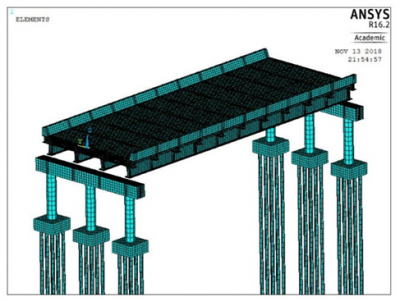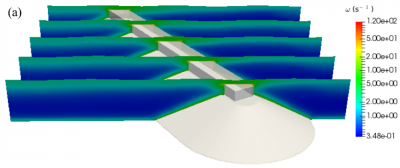The main goal is to investigate the behaviors of infrastructures, including buildings, bridges, and breakwaters, under combined loading conditions under multi-hazards. For this purpose, we have already carried out a few studies for low-rise wood buildings, short-span bridges, and low-crested and submerged breakwaters with finite element analysis or computational fluid dynamics analysis.
Building-Related publications:
- Ding, Z., Zhang, W., Zhu, D. (2021). “Three-Dimensional Equivalent Parameterized Beam Element for Nail Connections in Wood Residential Buildings.” Journal of Structural Engineering, 147(4), 04021029 https://doi.org/10.1061/(asce)st.1943-541x.0002983.
- Ma, X., Zhang, W., Li, X., Ding, Z. (2021). “Evaluating tsunami damage of wood residential buildings in a coastal community considering waterborne debris from buildings.” Engineering Structures, 244, 112761 https://doi.org/10.1016/j.engstruct.2021.112761.
- Ma, X., Li, X., Wu, D., Zhang, W. (2020). “Effects of Nonstructural Wall in Progressive Failure of Coastal Residential Buildings Subjected to Strong Winds.” Journal of Architectural Engineering, 26(1), 1–14 https://doi.org/10.1061/(ASCE)AE.1943-5568.0000373.
- Weston, J., Zhang, W. (2017). “Equivalent parameterized beam model for nailed connections in low-rise residential buildings.” Engineering Structures, 145, 12–21 https://doi.org/10.1016/j.engstruct.2017.05.002.
The low-rise wood building, occupying over 95% of all residential structures in the United States, caused large amounts of property loss during natural hazards, for instance, the hurricane-induced damages in the United States are in the order of trillions of dollars during the last one hundred years. The nail connections play a crucial role in structural analysis and damage prediction, serving as critical nodes in the loading path of wood residential buildings. To simulate the nonlinear behavior of the nail connections, non-oriented nonlinear spring elements usually are used for three translation degrees of freedom (DOFs). However, the three DOFs are decoupled as three independent springs, and therefore their coupled effects cannot be included in the modeling scheme, which leads to inconsistency for displacement trajectories. We proposed an equivalent parameterized beam element to solve the current problems and simplify the modeling process. More long-term effects such as water ingress and corrosions could be integrated into the element. Meanwhile, the static analysis with constant wind loadings is too simple to capture realistic building performances. We included direct loading time histories in the database-assisted design method to capture the progressive responses of coastal buildings.
In the current codes and specifications, structural and nonstructural components in low-rise residential wood buildings are differentiated from each other when evaluating their functions in terms of safety. However, for existing low-rise residential wood buildings in coastal communities, after years of exposure and continuous operations, significant damage could have accumulated in the structural and nonstructural components or their connections. As a result, the loading path could have shifted differently compared with the original design. Therefore, we built high-fidelity finite-element models for typical low-rise residential wood buildings including typical structural and nonstructural components to evaluate the functionality of the nonstructural walls under extreme loading conditions.
A physical-based approach considering the effects of building-generated debris impacts on neighboring buildings is proposed to predict the tsunami-induced damage of entire communities. The effects of the waterborne debris generated from the upstream collapsed buildings are considered to update the damage maps of the community to show failed buildings at different flow directions. The failure rate map of the entire community with the consideration of building-generated debris impacts is further obtained. Fragility curves of single buildings are also obtained with the inundation depth treated as a random variable.

Figure 1. Wind pressure contour in finite element model with database-assisted design method

Figure 2. Satellite map of the studied community
Bridge Related publications:
- Ma, X., Zhang, W. (2022) “Dynamic Amplification Effects of Scour and Debris Impacts for Short Span Bridges”, Engineering Structures, 252(1), February 2022, 113644 https://doi.org/10.1016/j.engstruct.2021.113644.
- Ma, X., Zhang, W. (2020) “Fatigue Life of Weldment Details of Existing Orthotropic Steel Bridge Considering the Scour Effects”, ASCE Journal of Bridge Engineering, 25(10). October 2020. https://doi.org/10.1061/(ASCE)BE.1943-5592.0001612.
- Lu, Q., Zhu, J., Zhang, W. (2020) “Quantification of Fatigue Damage for Structural Details in Slender Coastal Bridges Using Machine Learning Based Methods”, ASCE Journal of Bridge Engineering, 25(7). https://doi.org/10.1061/(ASCE)BE.1943-5592.0001571.
- Zhu, J., Zhang, W., Li, X. “Fatigue Damage Assessment of Orthotropic Steel Deck Using Dynamic Bayesian Networks”, International Journal of Fatigue. 118(1), p.44-53. https://doi.org/10.1016/j.ijfatigue.2018.08.037 Jan. 2019
- Zhu, J., Zhang, W., and Wu, M.X. (2018). “Coupled Dynamic Analysis of Vehicle-Bridge-Wind-Wave System.” ASCE Journal of Bridge Engineering, 23(8). https://doi.org/10.1061/(ASCE)BE.1943-5592.0001268 . August, 2018.
- Zhu, J., Zhang, W. (2018). “Probabilistic Fatigue Damage Assessment of Coastal Slender Bridges under Coupled Dynamic Loads.” Engineering Structures, 166(7), p. 274-285. https://doi.org/10.1016/j.engstruct.2018.03.073 . July, 2018.
- Zhu, J., Zhang, W., and Wu, M.X. (2018). “Evaluation of Ride Comfort and Driving Safety for Moving Vehicles on Slender Coastal Bridges.” ASME Journal of Vibration and Acoustics, 140(5), 051012. doi:10.1115/1.4039569 Apr. 2018.
- Zhu, J. and Zhang, W. (2017). “Numerical Simulation of Wind and Wave Fields for Coastal Slender Bridges.” ASCE Journal of Bridge Engineering, 22(3), 04016125, 10.1061/(ASCE)BE.1943-5592.0001002. Mar. 2017.
Serving as critical links in the transportation network for coastal regions, coastal slender bridges could constantly experience complex dynamic interactions with strong winds and/or high waves during extreme weather conditions, in addition to moving vehicles, such as cars, trucks, or trains. Continuously repeated stress cycles, as well as corrosive coastal environments, could cause significant fatigue damage accumulations at complicated weldments of the orthotropic steel deck (OSD) during lifetime, which could be critical and might affect structural safety and reliability. Challenges, such as realistic load characterization, modeling and simulation of complex structures, model parameter identification and calibration as well as uncertainty quantification, exist when evaluating the dynamic performance and fatigue damage of structural details in the vehicle-bridge-wind-wave (VBWW) system. To address these challenges, our research group has proposed a list of versatile and efficient numerical schemes to enable: (1) comprehensive dynamic performance analysis of coupled VBWW system; and (2) probabilistic assessment and prediction of fatigue damage of OSD accounting for various uncertainties.
A general analytical VBWW platform is first established based on the finite element analysis (FEA) software ANSYS and programing software MATLAB. With the established VBWW platform: (1) global dynamic responses of the vehicle-bridge system subjected to various service and extreme wind and wave loads can be rationally predicted; (2) comprehensive vehicle driving safety and ride comfort evaluations are also carried out using current state-of-art evaluation criterion. As an extension of the VBWW platform, two probabilistic fatigue damage assessment schemes were developed based on machine learning algorithms. The first one is to integrate the multi-scale FEA and the support vector machine (SVM) for fatigue reliability evaluation considering life-cycle stochastic dynamic loads. The second one is to use the dynamic Bayesian network (DBN) for fatigue damage diagnosis and prognosis of an OSD through integrating the physics-based model with field inspections while accounting for the associated uncertainties. Through the two established numerical schemes, the fatigue damage of the coastal bridge in the context of VBWW system can be evaluated.
During extreme flooding events, bridges could experience large lateral displacements or even collapse due to either strong hydraulic forces or the effects of large waterborne debris, such as tree branches. The additional lateral hydraulic forces and the acceleration of bridge scouring process due to temporary accumulated dams were investigated by researchers. Several debris impact force models were proposed to determine the loading effects applied on bridges. However, very few studies were conducted on the dynamic responses of bridges during flooding events considering the effects of large wood debris (LWD) as a combination of additional lateral hydraulic forces, foundation scour, and direct debris impacts. Therefore, we performed numerical analyses for bridges subjected to foundation scour and LWD impacts corresponding to flooding events. The hydraulic forces applied on the bridges were updated considering an extra blocking area due to debris accumulation. The collision forces due to floating woody debris were also introduced into the vehicle-bridge coupling system. We proposed a modified dynamic amplification factor (DAF) to consider the effects of debris impacts. Introducing possible debris impacts during flooding events into the dynamic analyses of bridges brings a more realistic estimation for the safety of bridges. The DAFs of bridges can be further taken as a guide for the supplements of design codes. The updated reaction forces would help to guide the risk mitigation of deck unseating.
The fatigue life of various weld joints is evaluated with various global scour depths and local scour depths to investigate the effects of foundation scour on structural reliability. Considering the possible waterborne debris such as large wood debris, the structural behaviors of short-span bridges with various span lengths and foundation scour depths are predicted to propose a parameter for simplifying dynamic analyses of bridges subjected to debris impacts. To further predict nonlinear behaviors and possible damages of bridge foundation subjected to large waterborne debris impacts, a constitutive model of concrete considering viscoplasticity and damage is updated in ANSYS with the implementation of various equations of the strain rate effects.

Figure 3. Finite element model of the orthotropic steel bridge
Coastal Infrastructure Related publications:
- Li, X., Zhang, W. “3D numerical simulation of wave transmission for low-crested and submerged breakwaters.” Coastal Engineering, 152 https://doi.org/10.1016/j.coastaleng.2019.103517.
Low-crested and submerged breakwaters, serving as one of the coastal defensive structures, are usually used to dissipate wave energy and help reduce wave impacts on coastal infrastructures and communities, especially during extreme weather events, such as hurricanes or tsunamis. Many recent post-disaster surveys indicated that breakwaters did not perform as designed during some extreme weather events. The performance of the breakwaters subjected to strong waves is still not clear especially when the breakwaters turn into the submerged condition. Meanwhile, many studies on the breakwaters are usually carried out in a two-dimensional wave flume either experimentally or numerically. However, the incident wave could impact the breakwaters from any direction instead of only from the head-on direction, which should be a three-dimensional physical process of wave and breakwater interactions. Therefore, we conducted a three-dimensional numerical study to investigate the effect of three-dimensional interactions of obliquely incident waves and breakwaters on wave potential energy reduction based on the proposed energy transmission coefficient. Computational fluid dynamics (CFD) simulations are carried out in OpenFOAM to simulate the interactions between the wave and breakwater using a three-dimensional Reynolds- averaged Navier-Stokes (RANS) model together with the k-ω SST turbulence model. Two validation studies are performed to validate the applicability of the proposed numerical model in two-dimensional and three-dimensional numerical simulations. Sensitivity analyses are performed to investigate the effect of different parameters associated with breakwater geometries and incident wave properties on a two-dimensional submerged breakwater performance in reducing the transmitted wave height. The effects of incident wave angle on the transmitted wave energy reduction for a three-dimensional submerged and surface breakwater are then investigated and compared with the two-dimensional simulation results. The numerical studies indicate that a three-dimensional simulation is more appropriate to describe a breakwater behavior in the real-world scenario.

Figure 4. Turbulence specific dissipation rate around the submerged breakwater